
Owings is a town center and census-designated place (CDP) in northern Calvert County, Maryland, United States. The population was 2,149 at the 2010 census, up from 1,325 in 2000.

Prince Frederick is an unincorporated community and census-designated place (CDP) in Calvert County, Maryland, United States. As of the 2020 census, the population of Prince Frederick was 3,226, up from 2,538 in 2010. It is the county seat of Calvert County.

The Cove Point Light is a lighthouse located on the west side of Chesapeake Bay in Calvert County, Maryland.

Mount Pleasant is 2+1⁄2-story brick structure with a gambrel roof and is about two-thirds its original length. It is located near Upper Marlboro in Prince George's County, Maryland. Mount Pleasant was patented in 1697 to Richard Marsham, whose wife Anne was the daughter of Leonard Calvert, Governor of Maryland. Their grandson, Marsham Waring, inherited the home from his grandfather in 1713. His son, Richard Marsham Waring had a son, Richard Marsham Jr., born in 1733, who then inherited Mount Pleasant and Patented and Certified the tract of land dubbed "Mount Pleasant Enlarged" in 1760. On August 21, 1764, Richard Marsham Jr. sold the 451 ¾ acre tract of land to his brother John for £474.6s.9d. John later built the standing house in the years between 1764 and 1785. John died in 1813 and was buried at Mount Pleasant.
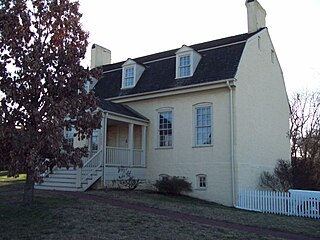
The William Hilleary House, or Hilleary-Magruder House, is a historic home located at Bladensburg in Prince George's County, Maryland, United States. The house is the only 18th-century stone, gambrel-roofed house in Prince George's County. It is now surrounded to the south and west by an exit ramp connecting Kenilworth Avenue with Annapolis Road.

Calvert Hills Historic District is a national historic district in College Park, Prince George's County, Maryland. It is roughly bounded on the north by Calvert Road, on the east by the Green Line metrorail corridor, on the south by the northern boundary of Riverdale Park, and on the west by Baltimore Avenue. It does not include Calvert Park on the southeast corner. Primarily a middle-class single-family residential neighborhood, it also includes some apartment houses as well as the College Park Post Office, a contributing property at 4815 Calvert Road.

Ash Hill, or Hitching Post Hill, is a two-story brick dwelling erected ca. 1840, and located on Rosemary Lane, in Hyattsville, Prince George's County, Maryland. The house was built by Robert Clark, an Englishman who was seeking space and quiet in contrast to the crowded city of Washington, D.C. In 1875, General Edward Fitzgerald Beale bought the property. Beale was well connected and known to have entertained President U.S. Grant, President Grover Cleveland and Buffalo Bill Cody. The house, with its foot-thick brick walls and hilltop site, is an imposing one, made even more so by the massive pillared porch which surrounds it on three sides. The porch was added by Admiral Chauncey Thomas who purchased the property in 1895.

Woodstock is a 2+1⁄2-story historic home located at Upper Marlboro, Prince George's County, Maryland, United States. The home is an outstanding example of a mid-19th-century plantation house with decorative elements in the Greek Revival style. The main block was probably built in the early 1850s by Washington Custis Calvert. The home is in the Tidewater house style.
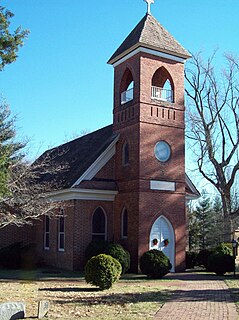
St. Thomas' Church is an Episcopal church in a rural setting, located at Croom, Prince George's County, Maryland. It is one of four congregations that have constituted the parish of St. Thomas in the Episcopal Diocese of Washington, the others including the Church of the Atonement in Cheltenham, the Chapel of the Incarnation in Brandywine, and St. Simon's Mission also in Croom.

Cedar Hill is a historic home located on 75 acres (300,000 m2) at Barstow, Calvert County, Maryland, United States. It is one of the few remaining cruciform dwelling houses existing in Maryland, built in the 18th century that is typical of 17th-century architecture. It is a 1+1⁄2-story house with a 2-story porch tower, built of brick laid in Flemish bond. It is now operated as a bed and breakfast, meeting hall, and retreat center.

Cornehill is a historic home located at Parran, Calvert County, Maryland, United States. It is a five-bay-long two-story Georgian brick house laid in Flemish bond with a steeply pitched gable roof with an exterior chimney at each gable end. One brick on the southwest corner contains the date 1786 and the initials "T.F." The initials purportedly refer to Thelbert Freeland, a member of an influential family in northeastern Calvert County. Outbuildings include slave quarters to the south of the house, and a tobacco barn with oak framing. During the majority of the 18th century, the Mackall family, large Calvert County landowners, held Cornehill, or "Cornhill."

Grahame House, Graham House, Mansion House, Graeme House, or Patuxent Manor, is a historic home located at Lower Marlboro, Calvert County, Maryland. It is an 18th-century original 1+1⁄2-story brick shell laid in Flemish bond with a steeply pitched gable roof. Later alterations have included the purchase and removal of the fine paneling throughout the house to the Henry Francis du Pont Winterthur Museum. Charles Grahame, for whom the home is named, was associated with Frederick Calvert, sixth Lord Baltimore, through Grahame's brother, David Grahame and with Thomas Johnson, first elected Governor of the State of Maryland, through Grahame's son.
La Veille, or La Veille Place, is a historic home located at Mutual, Calvert County, Maryland, United States. It is a 1+1⁄2-story gambrel-roofed brick house, of Flemish bond construction. A number of early-19th-century outbuildings include: a log corn crib, three barns, several small sheds, and a frame house that was created by the joining of two 18th-century log slave quarters. Between the "Quarters" and the main house is the La Veille family cemetery, enclosed within an elaborate late-19th-century wrought iron fence.

Preston-on-the-Patuxent is a historic home located at Johnstown, Calvert County, Maryland, United States. It is a modest 1+1⁄2-story brick house which has had several later additions made to it. While the home has a traditional construction date of about 1651, there is no structural evidence to indicate a date earlier than about 1725. It has been reported by Puritan knowledge that the original Preston home burned down in 1672, to be replaced by the present structure at a later date. Preston-on-the-Patuxent is popularly, if erroneously, known as the seat of the government of Maryland from 1654 to 1657, during the Puritan regime. The belief that the property was the "capital" comes from evidence that the Council, the Assembly, and the Provincial Court met "at Patuxent" in the 1650s. Richard Preston, a participant in each of the three bodies, most probably hosted their meetings in his dwelling located near the Patuxent River.
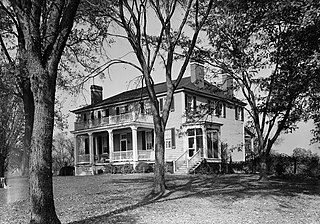
Taney Place is a historic home located at Adelina, Calvert County, Maryland, United States. It is a simple, two-story, hip-roofed, Georgian-style country house, dating from about 1750. It was the birthplace and childhood home of Roger Brooke Taney (1777–1864), who served as Chief Justice of the Supreme Court of the United States from 1836 to 1864.
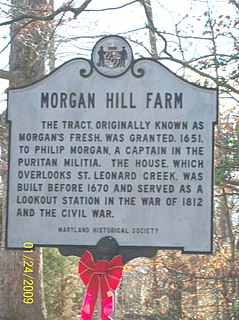
Morgan Hill Farm, also known as Morgan's Fresh or Hill Farm, is a historic home located at Lusby, Calvert County, Maryland. It is a 1+1⁄2-story gable-roofed frame house of a T-shaped plan, with single exterior chimneys on each of the three exposed ends. The original building appears to have been built about 1700, with extensively remodeled in the early 19th century. In 1952 a large rear wing was added to the house. Outbuildings include a one-story log servants' quarter, a log smokehouse, and a large tobacco barn.

The Chesapeake Beach railway station is a historic railway station located at Chesapeake Beach, Calvert County, Maryland, United States. It is composed of two one-story, hip-roofed sections; one part was once an open passenger boarding area that was later enclosed for storage. The station was erected in 1898, for the Chesapeake Beach Railway. It is now operated as a railway museum.

Linden is a historic home located near Port Tobacco, Charles County, Maryland, United States. It is a rambling frame house, consisting of a 2+1⁄2-story main block with wings, embodying many traditional characteristics of Tidewater architecture. The house is situated on the crest of a hill overlooking the Port Tobacco Valley. The home was begun early in the 1780s and enlarged about 1800, and in the late 1830s. Linden was probably built as a summer residence about 1783, by Henry Barnes, a wealthy Port Tobacco merchant and on a property that remained in the same family for over 300 years.

Linden Grove is a historic home located at Frederick, Frederick County, Maryland, United States. It is a 2+1⁄2-story, second-quarter-19th-century transitional Federal-Greek Revival Flemish bond brick house. A porch was added to the house in about 1900. Outbuildings include a one-story stuccoed hip-roofed smokehouse and a mid-late 19th century two-story tenant house, with an addition from about 1930.
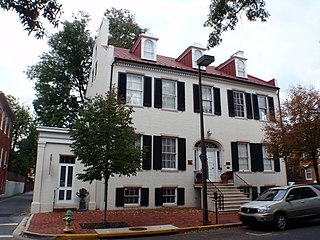
Loats Female Orphan Asylum of Frederick City is a historic home and former orphanage building located at Frederick, Frederick County, Maryland.
























